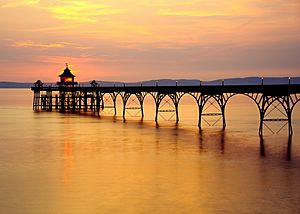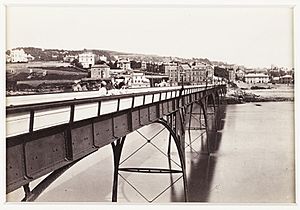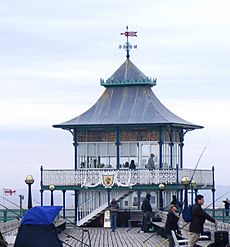Clevedon Pier facts for kids
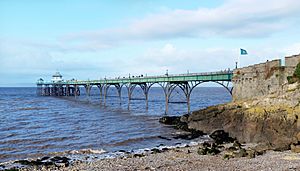
The pier from Clevedon seafront
|
|
| Type | Victorian Pleasure Pier |
|---|---|
| Carries | Pedestrians |
| Spans | Estuary of the River Severn |
| Locale | Somerset, England |
| Owner | North Somerset Council |
| Longest span | Eight 30-metre (100 ft) arched spans |
| Total length | 310 metres (1,020 ft) |
| Width | 5.0 metres (16.5 ft) |
| Clearance below | 4.3 metres (14 ft) (high water) |
| Opening date | 1869 |
| Listed status | Grade I listed |
| Toll | Adults £6, Children (4-15yrs) £4, Family (2 adults + up to 3 children) £15.00. Children under 4 free. |
| Coordinates | 51°26′36″N 2°51′48″W / 51.4432°N 2.8632°W |
Clevedon Pier is a famous seaside pier located in the town of Clevedon, Somerset, England. It stands on the eastern shore of the Severn Estuary. A famous writer, Sir John Betjeman, once called it "the most beautiful pier in England." In 2001, it was given a special status as a Grade I listed building, which means it's a very important historical structure.
The pier was built in the 1860s to attract visitors and to serve as a ferry port. People could take trains to Clevedon, then catch a ferry across to South Wales. The pier is 312 meters (1,020 feet) long. It has eight sections supported by strong steel rails, with a wooden walkway on top. There is also a building, called a pavilion, at the very end of the pier.
Clevedon Pier first opened in 1869. For almost 100 years, it was a popular spot for paddle steamer trips. However, in 1970, two sections of the pier collapsed during a safety test. There were plans to tear it down, but local people worked hard to raise money. With their efforts and some special grants, the pier was taken apart, fixed, and then put back together. It partly reopened in 1989 and was fully open again in 1998. The next year, it was named "Pier of the Year" by the National Piers Society. Today, the pier is still a busy place for steamers to dock and a favorite spot for both tourists and people who enjoy angling (fishing).
Contents
Where is Clevedon Pier?
The pier stretches out from the Clevedon seafront into the Severn Estuary. This estuary is a wide river mouth that separates South West England from South Wales. Near the pier entrance, you'll find the toll house, where visitors pay to enter. Right next to it is the Royal Pier Hotel, which was built a long time ago in 1823.
The coast at Clevedon has pebbled beaches and low rocky cliffs. The area around the pier is special because of its unique rocks. It's known as the Clevedon Shore Site of Special Scientific Interest, which means it's important for geology. You can find interesting minerals there, like baryte and different metal sulfides. There's parking available on an area above the rocky beach, close to the pier entrance.
The Pier's Story
How the Pier Was Built
During the Victorian era, Clevedon changed from a farming village into a popular seaside resort. This happened because transport became much better, especially with the new train line. People loved visiting the sea in the late 1800s. Clevedon had saltwater baths near the pier and special bathing machines on the beach. Many English seaside towns built piers in the 1850s to attract these new tourists.
A train line from Yatton railway station connected Clevedon to the main line from Bristol to Exeter. This made it easy for people from all over the country to visit. There was also an idea to use the pier as part of a route from London to South Wales, using steamers to cross the Severn Estuary. A special law was passed in 1864 to allow the pier to be built.
In November 1866, the Clevedon Pier Company was started. Building the pier cost £10,000. The engineers were John William Grover and Richard Ward, and the architect was Hans Price. The iron pillars were put up by a company from Liverpool. The pier's legs were made from old steel rails that had been used on a railway designed by Isambard Kingdom Brunel. Wooden planks were used for the walking surface. By August 1868, 183 meters (600 feet) of the pier were finished, and the last part was done by February 1869.
Opening and Early Days
Clevedon Pier officially opened on March 29, 1869. There was a big celebration with a parade, music bands, and even a cannon salute.
The number of train passengers crossing to South Wales by ferry decreased after the Severn Tunnel opened in 1886. This tunnel connected England to South Wales under the River Severn, making the ferry less necessary. However, the paddle steamer Waverley started visiting the pier in 1886. Along with other ships from the White Funnel Fleet, like Ravenswood and Britannia, it offered fun trips around the Bristol Channel.
In 1893, the pier head (the end part) was rebuilt with cast iron and a new wooden landing stage. The pavilion building at the pier head was finished in 1894. The Toll House and the nearby Royal Pier Hotel were both designed by Hans Price, the same architect who worked on the pier. In 1899, a storm washed away 6 meters (20 feet) of the pier's wooden surface. In 1910, another storm damaged the landing stage, which was then replaced with a concrete one in 1913.
The pier remained popular between the First and Second World Wars and into the 1960s. Steamers like the PS Bristol Queen (1946) and PS Cardiff Queen (1947) visited often.
The Collapse and Restoration
On October 16, 1970, two sections of the pier (spans 7 and 8) collapsed. This happened during a stress test, which was a safety check required for insurance. Large tanks filled with water were placed on the pier to see how much weight it could hold. The first six sections passed the test, but the seventh section broke, bringing down the eighth section too. Only the pier head and the pavilion at the end remained standing.
After the collapse, a group called the Clevedon Pier Preservation Society was formed in 1972. They started working to save and restore the pier. The local council wanted to tear it down in 1979, but a public meeting decided in 1980 that it should be kept. The pavilions from the end of the pier were moved ashore in 1982 for safekeeping. In 1984, the Toll House was opened as an exhibition center.
A big step forward happened in 1984 when English Heritage and the National Heritage Memorial Fund gave a lot of money (one million pounds) for the restoration. Other groups also helped with funding. The pier was taken apart in 1985 and moved to Portishead dock for repairs. It was then put back together in 1986.
After a long effort by local people to raise money, the pier finally reopened. Sir John Betjeman, who loved the pier, helped support the fundraising. Some money was raised by people "sponsoring planks" – small brass plaques with names or messages were put into the wooden planks and benches to thank donors. The main part of the pier reopened on May 27, 1989. The pierhead, however, was still closed. It wasn't until May 23, 1998, that the pier was fully restored and opened to the public, thanks to money from the Heritage Lottery Fund. In 1999, Clevedon Pier was named "Pier of the Year" and also won a Civic Trust Award. In 2001, it was again recognized as a Grade I listed building.
Today, the landing stage at the end of the pier is used by the historic steamers, the Waverley and the Balmoral, during the summer. It's also a popular spot for angling (fishing). There's a cafe at the pierhead and a souvenir shop in the toll house. The top floor of the toll house has an art gallery that changes its exhibition every month. The pier is open every day of the year except Christmas Day.
Clevedon Pier has also been featured in movies and music videos. Scenes from the 2010 film Never Let Me Go were filmed near the pier. The music video for One Direction's song "You & I" was also filmed on Clevedon Pier. In October 2024, after the death of One Direction singer Liam Payne, fans visited the pier to lay flowers at the One Direction plaque, which was put there to remember the music video filming. A plaque was installed on the pier in Liam Payne's memory in January 2025.
How the Pier is Built
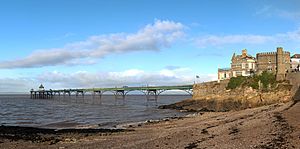
The pier is 312 meters (1,020 feet) long and stands 14.6 meters (48 feet) above the water at high tide. Each of its eight sections is 30 meters (100 feet) long. The legs of the pier are made from special steel rails that are riveted together. These rails form a strong support system. The main support piles, which are made of cast iron, are 0.6 meters (2 feet) wide at the bottom, where they meet the seabed. In total, about 370 tons of wrought iron were used to build the pier.
The Severn Estuary has one of the biggest tidal ranges in the world. This means the difference between high tide and low tide can be huge, up to 14.6 meters (48 feet)! This is second only to the Bay of Fundy in Canada. Because of this large tide, the pier's legs are mostly visible at low tide but almost completely covered by water at high tide. The landing stage at the end of the pier has several levels, so boats can dock safely no matter how high or low the tide is.
Images for kids
See also
- List of piers
- List of piers in the United Kingdom
- Grade I listed buildings in North Somerset


